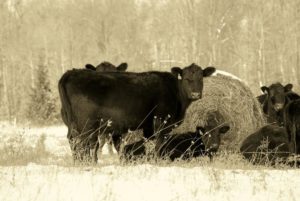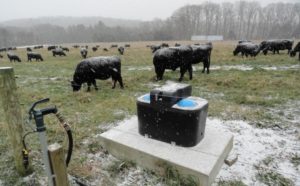Bale Grazing: Feed the Cattle, Feed the Pasture
At Angus Glen Farm, the two areas where we’ve made the greatest gains in winter feeding efficiency in recent years are by reducing human and mechanical energy inputs (my time and tractor time). Several years ago we transitioned to outwintering and “bale grazing”. This strategy can be used in different ways on different farms, but in our own case we lay out a two-day supply of hay in each paddock and then rotate the cows the same as during the grazing season. We have 75 permanent paddocks across 270 acres of pasture, so we can normally set out an entire winter’s supply of hay at once. The cows start “bale grazing” once they finish grazing stockpiled pasture in mid-to-late December. We don’t use ring feeders, and have found that the amount of waste hay is about the same whether the cows are given a 1-day supply or a 2-day supply of hay in each paddock. The amount of waste hay increases significantly if more than a 2-day supply is available. We have also experimented the past two years with leaving the natural “jute” fiber twine on the bales to save time and keep the bales intact longer during feeding. No problems yet on our farm, but this could pose a health risk if animals consume excessive amounts of twine or become entangled – so experiment at your own risk!
Watching the 10-day forecast is important when outwintering livestock. We move the herd to sheltered, wooded areas before storms and to sacrificial paddocks during thaws. We manage several conifer plantations on the farm as “living barns” where the herd can be moved temporarily during extreme winter weather. It’s important not to repeatedly “beat up” these wooded shelter areas, nor to allow excessive accumulation of waste hay as this will eventually impact tree health.
Some other benefits of outwintering include:
- Cows appear to be happier and healthier by moving around all winter rather than being confined to a muddy barnyard for months at a time. They also stay much cleaner and are able to bed on waste hay in recently bale-grazed paddocks.
- Much less ringworm in the herd.
- We are able to rejuvenate selected paddocks each year through concentrated feeding of hay (nutrients), followed by light frost seeding in the spring. Even without frost seeding, a vibrant sward of grass and forbs should return by mid-summer if care is taken to temporarily remove animals during soft ground conditions.
Even on pastures with wetter, heavier soils graziers should be able to feed at least part of their hay on pasture during frozen ground conditions (if the animals can be moved relatively easy back and forth from a winter yard to the pastures). Every bale that is fed on pasture is that much less manure to clean up in the spring and one more dose of fertility where it matters most.

Cows lounging and ‘grazing’ on the bales.
Another strategy is to focus bale-grazing on one pasture that needs improvement. By spring the pasture may be a mess and ready for renovation, either frostseeding or tillage and seeding, depending on the amount of pugging and wasted hay left. This pasture will be delayed in spring-summer grazing, or completely out of the grazing system for an extended period. Bales can be placed in the pasture and separated by temporary fencing to give the cattle limited access to them. The challenge comes with deep snow; fences may get buried and someone needs to get there to drop the fences when time for access to the next set of bales. If excess hay is available, temporary fencing may not be needed.



We’ve been bake grazing last couple of years and have had a hard time since last 2 years have been really wet. We feedlot our calves so this has helped lighten up our lots. But it seems hard on pastures and wastes alot in really wet weather and is a health concern since cows often eat dirty hay that has been trampled. Any advice would be appreciated.